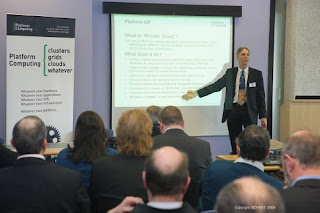
This indicates that there is, indeed, a huge amount of interest in what cloud computing is and how to achieve it. But to an even larger degree it was about saving money and performing more efficiently and flexibly while maintaining reliability, availability, security, compliance and audit capabilities.
The key messages that I delivered were around the fact that the cloud is not just a technology driven solution but also very business driven. This includes business drivers such as implementing large scale strategies, exploring operational/business psychology within organizations and getting all of the stakeholders to the table.
For instance, to really become efficient, the cloud must be implemented across as large a set of resources as possible, meaning that multiple departments of the government must be willing to all get together and use the same facility. Governments considering cloud infrastructures must also make sure that the data center facilities people are fully participating and can host this type of system. (It will probably quite a bit denser in terms of heat, power, weight, etc. than what they traditionally manage.), It’s also necessary to get the application and database people into the room to understand the implications of this new methodology and how they should design and architect their solutions to make best use of it. For example, do they handle all H/A capabilities in the app space now (a la Google, with fail in place) or do they do things more traditionally, thus requiring dual PSUs, N+1 or better fans, multiple servers for H/A, etc.?
And possibly the most important aspect, how do you make the systems, network, storage, hypervisors, OSes, etc. all seem completely replaceable without disruption? This is where having a tool such as Platform Computing's ISF (Infrastructure Sharing Facility) can be so powerful ... if you want to change any of the pieces, including new generation VM capabilities (or more realistically have a heterogeneous setup consisting of multiple types)\ or change the application itself (via a front end submission facility that does all of the right things for the user, regardless of the underlying application) then you begin to truly explore the capabilities of a virtualized data center.
-Phil Morris
CTO, HPC BU
Platform Computing

1 comments:
Its a nice article. Thanks for sharing information on cloud computing. I got a complete information about the Cloud computing and its services from the Cloud Computing and Virtual Conference 2009 which is the World's largest and virtual conference on Cloud computing. I got a good opportunity to meet and talk with the World's leading experts on Cloud computing.
Post a Comment